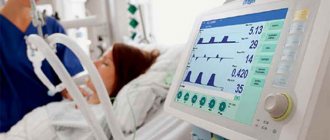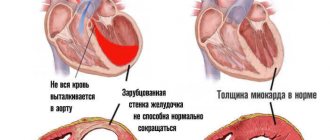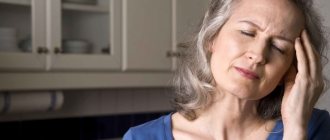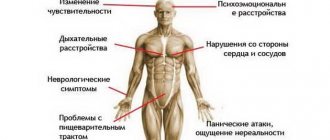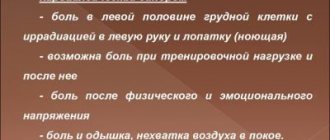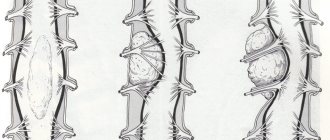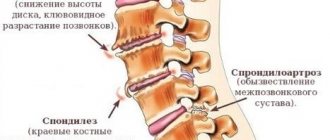Some patients have to deal with an unpleasant phenomenon - pain in the heart during VSD (vegetative-vascular dystonia). Doctors note that these unpleasant sensations are not life-threatening, but they worsen its quality and can create inconvenience.
- What are the pains in the heart with VSD?
- How to determine that this is pain of cardiac origin?
- What is the danger of heart pain during VSD?
- What kind of pain in the heart occurs with VSD?
- How to treat this disorder?
2Heart pain
Chest pain
Not only angina pectoris or myocardial infarction can cause heart pain, but also vegetative-vascular dystonia. Although, it would be more correct to call it neurocirculatory dystonia. Pain syndrome with vegetative-vascular dystonia of the cardiac type has its own characteristics. The pain can range from minor to unbearable. Patients often report a feeling of discomfort in the heart area. The duration of pain can be from a few seconds to several days.
According to the nature of pain in vegetative-vascular dystonia of the cardiac type, patients describe it as stabbing, aching, vague, dull. It also happens that patients cannot convey the nature of the pain. Painful sensations associated with central depression are not constant. They can change their location, intensity, character. With vegetative-vascular dystonia, pain can radiate to the left arm. Excessive emotional stress, fears and worries can lead to their occurrence.
Taking sedative medications
Some patients note a connection with the premenstrual period, the period after physical activity. A distinctive feature of these heart pains is the positive effect of taking sedative medications. At the time of the attack, patients may experience fear and anxiety, anxiety, and depression. Pain in vegetative-vascular dystonia of the cardiac type does not prevent patients from continuing physical activity.
On the contrary, some patients say that in order to “get away” from the pain, they need to be distracted by some other activity. What we talked about is the “classic” heart pain associated with low blood pressure. In some situations, an intense burning sensation may be felt in the heart area, and the sensitivity of the skin in this area is increased. Some patients may report pain in the chest, however, as a rule, this pain can disappear with physical activity.
Cardiophobia varies in anxiety disorder severity
There are three types of development and course of this phobia; they can be distinguished only by fully studying the physical symptoms of cardiophobia and the person’s complaints. These forms are presented in the following table.
| Forms of phobia | Symptoms | Reasons that could trigger the appearance of a phobia |
| Pseudoreumatic | A person is tormented by pain in the area of the heart (the patient describes the symptoms of rheumatic disease), the heartbeat quickens, shortness of breath appears, and discomfort is felt in the blood vessels. The most important thing is that doctors’ studies confirm that the person is healthy. | Chronic sore throat, diagnosed with heart disease in relatives or friends, excessive suspiciousness. |
| Pseudo-infarction | When the patient feels discomfort, pain in the heart and thinks that these are the first symptoms of myocardial infarction, he waits for it and prepares for a critical situation. For this reason, he visits doctors quite often, does all kinds of examinations, and ultrasounds of the heart. He takes medications, but they do not improve his condition. During the next attack, a person develops red spots on his face and neck, his heartbeat and breathing become noticeably faster, and he begins to sweat profusely. | If the patient studied in detail the symptoms and course of myocardial infarction, or if loved ones were sick or died from such diseases, this can cause severe hypochondriacal conditions and anxiety-phobic disorder. |
| Neurotic | It is difficult for the patient to describe his sensations (the descriptions of the problems are not clear); he cannot indicate the place where it hurts and how it hurts. Sometimes a person himself cannot understand where and what is wrong, but indicates that this manifests itself specifically in the chest area. | Stress, overwork, tension due to conflicts, severe anxiety, separation from a loved one. |
What to do during a cardiac attack
If a loved one suffers from VSD, you need to learn how to come to his aid. Due to competent behavior, it is possible to reduce the severity of the attack and reduce its duration.
If a person is experiencing VSD pain, he needs to find out what to do from a specialist in advance. The doctor recommends the following:
- Provide rest to the patient.
- Lay or sit him in a comfortable position.
- Give sedatives.
During an attack, psychological support should be provided to the person. It is necessary to reduce his anxiety level so that the negative symptoms recede. If in any doubt, it is better to call an ambulance to rule out a heart attack.
Do you still think that it is difficult to cure hypertension?
Judging by the fact that you are reading these lines now, victory in the fight against pressure is not yet on your side...
The consequences of high blood pressure are known to everyone: these are irreversible damage to various organs (heart, brain, kidneys, blood vessels, fundus of the eye). In later stages, coordination is impaired, weakness appears in the arms and legs, vision deteriorates, memory and intelligence are significantly reduced, and a stroke can be triggered.
window.RESOURCE_O1B2L3 = 'kalinom.ru'; var m5c7a70ec435f5 = document.createElement('script'); m5c7a70ec435f5.src='https://www.sustavbolit.ru/show/?' + Math.round(Math.random()*100000) + '=' + Math.round(Math.random()*100000) + '&' + Math.round(Math.random()*100000) + '= 13698&' + Math.round(Math.random()*100000) + '=' + document.title +'&' + Math.round(Math.random()*100000); function f5c7a70ec435f5() { if(!self.medtizer) { self.medtizer = 13698; document.body.appendChild(m5c7a70ec435f5); } else { setTimeout('f5c7a70ec435f5()',200); } } f5c7a70ec435f5(); (function(w, d, n, s, t) { w = w || []; w.push(function() { Ya.Context.AdvManager.render({ blockId: 'RA-336323-4', renderTo : 'yandex_rtb_R-A-336323-4', async: true }); }); t = d.getElementsByTagName('script'); s = d.createElement('script'); s.type = 'text/javascript '; s.src = '//an.yandex.ru/system/context.js'; s.async = true; t.parentNode.insertBefore(s, t); })(this, this.document, 'yandexContextAsyncCallbacks '); (function(w, d, n, s, t) { w = w || []; w.push(function() { Ya.Context.AdvManager.render({ blockId: 'RA-336323-3', renderTo : 'yandex_rtb_R-A-336323-3', async: true }); }); t = d.getElementsByTagName('script'); s = d.createElement('script'); s.type = 'text/javascript '; s.src = '//an.yandex.ru/system/context.js'; s.async = true; t.parentNode.insertBefore(s, t); })(this, this.document, 'yandexContextAsyncCallbacks '); (function(w, d, n, s, t) { w = w || []; w.push(function() { Ya.Context.AdvManager.render({ blockId: 'RA-336323-2', renderTo : 'yandex_rtb_R-A-336323-2', async: true }); }); t = d.getElementsByTagName('script'); s = d.createElement('script'); s.type = 'text/javascript '; s.src = '//an.yandex.ru/system/context.js'; s.async = true; t.parentNode.insertBefore(s, t); })(this, this.document, 'yandexContextAsyncCallbacks '); (function(w, d, n, s, t) { w = w || []; w.push(function() { Ya.Context.AdvManager.render({ blockId: 'RA-336323-8', renderTo : 'yandex_rtb_R-A-336323-8', async: true }); }); t = d.getElementsByTagName('script'); s = d.createElement('script'); s.type = 'text/javascript '; s.src = '//an.yandex.ru/system/context.js'; s.async = true; t.parentNode.insertBefore(s, t); })(this, this.document, 'yandexContextAsyncCallbacks '); (function(w, d, n, s, t) { w = w || []; w.push(function() { Ya.Context.AdvManager.render({ blockId: 'RA-336323-1', renderTo : 'yandex_rtb_R-A-336323-1', async: true }); }); t = d.getElementsByTagName('script'); s = d.createElement('script'); s.type = 'text/javascript '; s.src = '//an.yandex.ru/system/context.js'; s.async = true; t.parentNode.insertBefore(s, t); })(this, this.document, 'yandexContextAsyncCallbacks ');
Diagnostics
Any pain symptom in the heart should be an impetus to visit a doctor, however, at the first examination, the therapist may not make the correct diagnosis, telling the patient that there are no problems with the heart
This does not mean that you can ignore unpleasant symptoms in the future.
To assess the condition of the heart muscle, a comprehensive diagnosis should be carried out, consisting of the following examinations:
- ECG - determines the functional state of the heart;
- ECHO is one of the ultrasound methods; the study shows changes in the valvular apparatus of the heart and general morphology;
- MRI of the heart allows you to obtain maximum information about the physical condition of the organ.
All these activities will help establish a diagnosis and prescribe treatment. If the heart muscle itself is in perfect order, and the blood vessels are functioning as they should, the doctor is inclined to assume that the disorder is only in the autonomic and nervous system.
Prevention
Stress is a common cause of osteochondrosis and autonomic disorders. To prevent both pathologies, which are closely related to each other, one should avoid nervous overstrain, give up bad habits, avoid physical and moral exhaustion, and alternate work and rest. To maintain the elasticity of cartilage tissue and the tone of blood vessels, you should drink at least 2 liters of still water daily.
Osteochondrosis is an inflammatory and degenerative progressive disease, which is accompanied by the destruction of the osteochondral tissue of the spinal column. The chronic course of the pathology leads to the development of VSD (vegetative-vascular dystonia). Disruption of the autonomic nervous system aggravates the course of osteochondrosis. Destruction of intervertebral discs is more common in adulthood and old age, therefore clinical signs of dystonia develop later than with VSD due to other causes. In this case, symptoms of the spine and nervous system are diagnosed. VSD and osteochondrosis often occur after 40 years, with the same frequency in men and women. Dystonia associated with other factors is more often detected in women
It is important to correctly establish the cause of the development of the disease - the effectiveness of treatment and the prognosis of the disease depend on this
How are VSD osteochondrosis related? Why can degenerative spinal disorders affect the functioning of the nervous system?
In the paravertebral region there are arterial vessels and nerve trunks that feed nerve cells and carry information to the brain from other systems of the body.
If structural changes in the spinal column develop, the vessels narrow and the nerve trunks are compressed by the processes of the vertebrae. With osteochondrosis, muscle tension forms in the frame of the back and neck, which aggravates the compressive effect on the nerves and arteries. As a result, the brain does not receive enough oxygen-rich blood. Hypoxia and disruption of the autonomic nervous system develop. Thus, with osteochondrosis and VSD, a connection is formed like a vicious circle. The progression of degenerative changes causes the appearance of new symptoms of dystonia, which worsens the course of osteochondrosis and increases the risk of complications.
Causes of VSD and chondrosis:
- congenital and acquired curvatures of the spinal column;
- spinal injuries;
- metabolic disorders in the body;
- excessive physical activity;
- sedentary lifestyle (weakness of the muscular frame of the back);
- hereditary factor.
A genetic predisposition to neuroses leads to an earlier onset of VSD with degenerative changes in the spine.
Causes
Pain in the heart with vegetative-vascular dystonia manifests itself due to various factors - nervousness, stress, disease, heredity. In children, VSD can occur in 10% of cases.
From a medical point of view, this diagnosis is caused by a discrepancy between the pace of development of the nervous system and physical growth. As well as excessive physical and mental stress.
Heart pain during VSD can occur for various reasons, the most common of which are the following:
- chronic diseases – colitis, pancreatitis, gastric ulcer;
- diseases of the nervous, cardiovascular and endocrine systems;
- head injuries;
- allergic diseases, intoxication;
- stress, being in a constant “peak” position, overexertion, overwork;
- consequences of acquired infectious diseases;
- physical, emotional or mental stress;
- sudden change of environment, time zone or climate;
- hormonal imbalance that occurs in women during menstruation, pregnancy, childbirth, as well as in adolescents;
- excessive use of tobacco and alcohol;
- nervousness and lack of sleep;
- colds;
- “sedentary” work, sedentary lifestyle;
- unbalanced diet, insomnia, depression.
In addition, heart pain occurs in a person prone to self-hypnosis.
4Headaches
Migraine pain
Pain resulting from cerebral vascular dystonia can be of different types. All these disorders belong to the section of vegetative-vascular dystonia of the cerebral type. This definition means that the vessels of the brain do not always react as needed in a certain situation. In addition to the headaches discussed in the article, pre-syncope and paroxysmal dizziness may also occur.
A fairly large group is represented by migraine pain. They have a paroxysmal character, which is manifested by a sudden onset and the same ending. Migraine pain has its own periodicity. For some this may be 2 times a week, for others - once a year. Patients note that the attack is associated with eating foods rich in tyramine - cocoa, chocolate, nuts. The duration of pain can be from several minutes to days.
An attack of migraine headaches is preceded by a period of warning signs. At such moments, patients are worried about severe weakness and malaise. At the very moment of the attack, the pain can be so severe that the patient experiences nausea and vomiting. These pains are localized, usually patients point to the frontal-temporo-parietal region. Loud sounds, excessive noise and bright lights only increase the pain.
Severe drowsiness and weakness
In addition to nausea and vomiting, at the height of the headache, pre-fainting states may occur, in which patients complain that their ears are “stuffy,” tinnitus appears, general weakness, and loss of consciousness may occur. After a migraine attack, there comes a period during which patients note severe drowsiness and weakness. There are several types of migraine. The simple form of migraine is described above. There is also an associated form of migraine, for which, along with the pain syndrome, there are disorders of other organs and systems.
You may feel dizzy and your ears may be blocked. This form of migraine, when the patient feels dizzy and the ears are blocked, is called the vestibular form. Migraine headaches may be accompanied by speech impairment, memory loss, visual and sensory disturbances. There are other, so-called special forms of migraine, when the pain syndrome has other characteristics. Pain may be localized in other parts of the body. During an attack, blood pressure may increase.
Presyncope or fainting conditions
Another form of vegetative-vascular dystonia of the cerebral type is pre-syncope or fainting conditions. In another way, this condition is called syncope. It occurs due to the fact that the blood supply to the brain is disrupted. As a rule, loss of consciousness is preceded by a period during which patients complain of tinnitus, dizziness, severe weakness, lack of air, and nausea. Such a pre-fainting period, if unaided, leads to loss of consciousness.
The skin becomes pale, breathing becomes shallow and frequent. Pre-syncope and fainting are followed by a period of severe weakness in patients. In addition to migraine pain, vascular pain may also occur, which also reflects improper regulation of cerebral vascular tone. Vascular pain does not have a “half” localization. They are felt by the patient in the occipital region and are pressing and squeezing in nature.
Treatment of the heart with VSD
VSD refers to diseases of the cardiovascular system, but does not affect the functioning of the heart. With this pathology, the autonomic nervous system suffers, which leads to unpleasant symptoms. Therefore, the treatment is carried out by a neurologist together with a psychotherapist.
For the treatment of heart disease in combination with dystonia, the following drugs are used:
- sedatives;
- tranquilizers;
- medications that improve cerebral circulation.
Each patient is given his own treatment regimen, which depends on the general condition and concomitant pathologies. Sometimes hormonal therapy is necessary, but often VSD can be treated without the use of medications. The following methods do an excellent job with these tasks:
- massage;
- acupuncture;
- physiotherapy.
To prevent new attacks, it is recommended:
- Sleep 8 hours a day.
- Normalize the regime.
- Eat properly and fully.
- Increase your level of physical activity.
- Get more positive emotions.
- To refuse from bad habits.
Only a combination of a healthy lifestyle and medications prescribed by a doctor can achieve excellent results. Without appropriate help, patients become dependent on attacks and lose the ability to live a normal life in society.
Mechanism of occurrence
Arrhythmia, which occurs against the background of vegetative-vascular dystonia, like the underlying disease, is functional in nature. In the absence of proper treatment, it becomes habitual, and the patient does not pay attention to it.
Normally, the sinus node (SU) is responsible for generating electrical signals that regulate the mechanical contraction of the heart. However, against the background of VSD and dysfunction of the autonomic nervous system, the order and intensity of the vagus nerve and sympathetic influences monitoring the work of the sinus node changes, which leads to harmless forms of arrhythmia.
VSD and heart.
Therefore, with vegetative-vascular dystonia, all your attention is directed to the heart. Any unpleasant sensations in the heart area instantly and very strongly affect your well-being
Any interruptions in the heart during VSD (irregular rhythm, increased heart rate, etc.) cause you to have a huge surge of fear of death.
With VSD, the pain is felt in the heart itself, but in reality it occurs in the area of the heart - in the left side of the chest or near the sternum. But you don’t pay attention to such a little thing: - Guard! Save! My heart hurts! Your subconscious specifically selects this, the most important and sensitive organ of your body, in order to intimidate you quite strongly and seriously. And in most cases, he manages to do this very successfully. After all, you can constantly observe and feel how the heart works - the sensation of heart contractions, the pulsation of veins. How other organs work is something you cannot notice or control. You cannot feel and control how gastric juice is secreted or how the liver works.
You constantly listen to the work of your heart, your hand probes the pulse on the other hand around the clock. Several times a day, you measure your blood pressure. The tonometer becomes your life partner, although you are still so young.
With great persistence, despite doctors’ statements about the complete health of your heart, you undergo various examinations one after another. And, of course, you almost constantly do ECGs and other fashionable and modern methods of examining the heart. All this is a completely useless exercise.
Heart pain with VSD is caused by a functional disorder of the autonomic nervous system and an incorrect reaction of the hormonal system. But it has nothing to do with organic heart disease.
Although, an ECG examination can be carried out to exclude hidden myocardial infarction and other possible organic diseases that cause similar cardiac symptoms.
Patients describe the feeling of pain in the heart during VSD with a variety of epithets. In the area of the heart - it stings, aches, presses, cuts, squeezes. It can be either periodic or constant, both dull and sharp or burning.
This whole condition is further aggravated by heart rhythm disturbances. Interruptions in the heart during VSD: extrasystole (extraordinary contraction of the heart), arrhythmia (erratic pulse), cardiac arrest (absence of one or more heart contractions), tachycardia (rapid heartbeat) - cause a particularly strong fear of instant death.
How does the heart hurt with VSD?
Pain in the heart area with VSD differs from heart pain, which is caused by organic diseases (coronary heart disease, myocardial infarction).
Heart pain with vegetative-vascular dystonia:
1. It does not occur during physical activity; on the contrary, it appears some time after it.
2. Very often it stops at rest, but appears with any movement. This means that pain is caused by the organs of movement in this area - myositis (inflammation of muscles), intercostal neuralgia.
3. Does not respond to taking medications that dilate coronary (heart) vessels - validol, nitroglycerin, as well as other cardiac drugs.
4. Reacts and decreases after taking sedatives - sedatives and tranquilizers (Corvalol, phenazepam, etc.).
5. When conducting examinations, no noteworthy disturbances in the functioning and condition of the heart are detected, except for incomplete blockade of the right or left bundle branches on the ECG, which does not in any way affect general health and is statistically found in every second person. In cardiology, incomplete bundle branch block is not considered as an independent disease. This condition has virtually no effect on anything, is often detected in completely healthy young people, and is also considered as a variant of the physiological norm.
6. Accompanied by a strong fear of death, which is growing all the time.
The less you pay attention to this pain, the less it will bother you. Treatment of pain in the heart area with VSD includes the prescription of sedative medications, auto-training on coming to terms with the fear of death and psychotherapy sessions
Treatment of pain in the heart area with VSD includes the prescription of sedative medications, auto-training on coming to terms with the fear of death, and psychotherapy sessions.
Mechanism of cardiac arrhythmia
Regular heart contractions occur due to the autonomic nervous system and the action of the endocrine glands. They affect the excitation of pacemakers located in the upper region of the right atrium, which are responsible for triggering the contraction of the heart.
The impulse signal emanating from the sinus node penetrates the atria and ventricles, provoking their contraction. During the normal and coordinated operation of these systems, the familiar heart beats occur.
There are cases when an impulse emanating from the sinus node does not always lead to a cardiac contraction, or one such signal can provoke several extraordinary contractions. It is precisely such minor disruptions that cause rhythm disturbances in the body’s main muscles.
Read about the treatment of atrial fibrillation with folk remedies in another article.
| Extracardinal | The causes are extracardiac in nature; arrhythmia can occur due to physical exertion, PMS, nicotine or alcohol poisoning. Also, dysfunction of systolic and diastolic contractions can appear for the following reasons:
|
| Cardinal | This type includes any heart disease, since they all disrupt the rhythm of contraction and impair the inflow and outflow of blood. |
| Idiopathic | The violation occurs independently, without being any complication. This type of violation is quite rare. |
The vagus nerve, which carries the brain signal about heart rate, is blocked during an attack of panic, fear, anxiety or overexcitement. All this increases the heart rate and for some time the contractions of the heart become uncontrollable for the brain.
Hormones and other chemicals disrupt the heart rhythm. For example, drugs negatively affect the sinus node, which interferes with the conduction of the impulse. Myocardial infarction or electric shock can disrupt the entire conduction system of the heart.
Muscle and joint pain
Muscle or joint pain in VSD has certain features, which makes it possible to exclude organic pathology of these structures:
- Instability. Discomfort disappears after normalization of the patient’s emotional state and elimination of the provoking factor. Infection, injury or other pathology is characterized by persistent pain.
- Marked fluctuations in pain intensity.
- There are no restrictions on the range of movements. Despite the discomfort, the patient can perform any exercise fully.
- Migration of pain. “Wandering” pain is often found in patients with VSD.
- Greater effect from treatment using sedatives than analgesics.
To decide on therapeutic tactics, a differential diagnosis of musculoskeletal pathology should be carried out. If it is excluded, then the presence of autonomic disorders is assumed.
Why does the heart hurt with VSD?
Neurocirculatory dystonia is a trigger, but not the cause of heart pain. They originate in the depths of the chest
It is important to determine not only how the heart hurts during VSD, but also what the nature of this pathology is
The most common causes of pain:
- conflict situations, stress;
- excessive physical activity, fatigue;
- prolonged insomnia;
- drinking alcohol;
- eating too hot food;
- lack of fresh air;
- sudden change in weather;
- changes in hormonal levels during menstruation in women.
Not all patients know that manifestations of dystonia are most often life-threatening. Many, experiencing VSD syndrome for the first time, succumb to panic and perceive the pathological condition as a harbinger of death. This is severe psychological trauma. Anticipation of new attacks contributes to the exacerbation of neurosis and the development of abnormalities that cause heart pain.
But often people, on the contrary, underestimate the seriousness of VSD, mistakenly believing that this is how banal fatigue manifests itself. Meanwhile, the functional disorder continues to progress and can lead to the development of hypertension and other diseases of the vascular system.
Neurogenic cardialgia
A doctor, collecting an anamnesis, based on the patient’s vivid descriptions of how his heart hurts during VSD, may suspect the presence of a disorder of a neurological nature.
Characteristic symptoms of psychogenic cardialgia are:
- short duration of attacks (about 3-5 minutes);
- rapid breathing, shortness of breath;
- blood pressure surges;
- tachycardia or bradycardia;
- intense sweating;
- no irradiation of pain to the jaw area;
- a false premonition of impending death.
Moderate tingling or dull heart pain with VSD occurs either during physical exertion or for no apparent reason. Heart failure is often accompanied by headaches, tinnitus, and sudden mood swings. However, with VSD, cardialgia is not fatal.
Classification of signs of cardialgia.
Cardioneurosis
This is a functional disorder of the cardiovascular system, resulting from abnormalities in the functioning of the autonomic nervous system. Scientists have discovered why the heart hurts during VSD, although there are no organic defects in it. Cardioneurosis most often develops in people with a tendency to depression, hysteria, or who have suffered traumatic brain injuries, neuroinfections, or prolonged asthenia.
Characteristic symptoms:
- stabbing cardialgia (the heart beats faster during VSD);
- difficulty breathing, feeling of lack of air;
- headaches, insomnia, increased irritability.
Endocrine system disorders
Many patients with diabetes and hypothyroidism gradually develop VSD, and the heart begins to malfunction. Asthenic conditions, often accompanying endocrine diseases, over time disrupt the activity of the central nervous system and cause changes in blood pressure and arrhythmias. With VSD, burning in the chest and other symptoms of cardialgia significantly worsen the patient’s quality of life and complicate the treatment of the endocrine organ.
Cardiac causes (coronary insufficiency)
However, it cannot be ruled out that the cause of chest pain during VSD is not only vegetative-vascular dystonia, but also pathologies of the heart itself. Coronary insufficiency is especially often diagnosed, in which blood circulation in the myocardial arteries becomes difficult. If a patient suffers from angina pectoris, the acute oxygen deprivation experienced by the heart muscle can lead to ischemia and even sudden death.
https://youtube.com/watch?v=A4uXaTYqYag
How to treat? how to fight?
But how to fix it, how to influence the nature of the thoughts of the VSD student, who has turned “viewing” the work of his heart into a real hobby! How and with what can you influence panic thoughts that only revolve around your own nature, the work of the main organs and, above all, the heart?
The purpose of the pills? It doesn’t sound very convincing, because every pill brought to your mouth always reminds you of the existing problem, and your thoughts will become even more panicky and stunned.
How can one interrupt a conditioned reflex connection, the end product of which is a functional disorder?
First of all, any VSD sufferer suffering from a similar problem should be informed that the condition he has is not organic, and more precisely, fatal, which never leads to death.
This is a functional disorder in which there is a slight malfunction in the functioning of the autonomic nervous system. And that is why one of its departments (sympathetic or parasympathetic) slows down or activates its activity.
And only with this should treatment and prevention of the problem that has arisen begin: the sick person must be confident in the safety of this functional disorder.
But what to do with the existing panic thoughts that never cease to revolve around the work of the entire cardiovascular system, often mentally imagining it (visualization)?
Only psychophysical influence can influence the nature of the mental activity of any person, including the VSD student. It is feasible physical work, as well as interesting spiritual and cultural work; only a conscious psychological attitude can influence panic thoughts, force them to change their content and flow evenly.
So, treatment for this condition should begin with normalizing the work and rest of a particular person. It is necessary to solve the individual problem of nutrition, sleep, and physical activity.
A person suffering from cardiac VSD should know that only feasible physical exercises train the coronary vessels of the heart, dilate them, and bring them into ideal condition.
Only adequate physical labor (physical exercise) normalizes blood pressure, strengthens the heart muscle, and makes the heart contract much less frequently, which will indicate its economical activity. That is why physical education should become part of the life of a person suffering from VSD.
A very effective tool in solving the problem of not only functional disorders of the heart is breathing with manual energy supplementation proposed by the author, which can be practiced several times a day, if you have free time.
We must not forget about the healing effect of the factors of Nature on man, which is always open to him and always ready to lend a helping hand.
Therefore, you cannot hide from it within four walls, but you must go into it in any weather, remembering that bad weather never happens.
In addition, a person who stays in the fresh air as much as possible not only experiences the influence of meteorological factors, but is exposed to the entire Energy of the Universe: gravity, the sun, stars, and a number of other planets, which also benefits his health.
You might also be interested in:
Clinical picture
With osteochondrosis and vegetative-vascular dystonia, many different symptoms are observed from the spine, nervous, cardiovascular, and digestive systems. Functional changes in internal organs associated with VSD must be differentiated from diseases of another nature. The effectiveness of the therapy depends on the correct diagnosis. Osteochondrosis of the cervical and thoracic spine leads to dystonia.
Cervical osteochondrosis, which causes disruption of the blood supply to the brain (vertebral artery syndrome), plays a significant role in disrupting the functioning of the autonomic nervous system. Damage to the thoracic spinal column leads to clinical symptoms of the lungs and heart.
Symptoms of VSD in cervical osteochondrosis:
- headache;
- discomfort and crunching when turning the neck;
- feeling of stiffness in the muscles of the neck and upper shoulder girdle;
- dizziness when walking and at rest;
- decreased visual and hearing acuity;
- noise in ears;
- coldness of the upper extremities;
- feeling of tingling or numbness in the fingers;
- fast fatiguability;
- drowsiness.
Symptoms of VSD in thoracic osteochondrosis:
- dyspnea;
- feeling of lack of air;
- difficulty breathing;
- pain in the heart area;
- increased heart rate;
- decreased or increased blood pressure;
- feeling of heart failure;
- pain along the intercostal spaces.
In addition to the listed clinical signs, symptoms of VSD are also identified from the spine. With VSD, the back often hurts in the affected area. With cervical osteochondrosis, discomfort in the neck area is disturbing, especially when turning the head or prolonged sitting position. With thoracic osteochondrosis, pain occurs between the shoulder blades, and it is difficult to tilt or turn the torso. Discomfort intensifies at the height of inspiration, during physical activity, and during a stressful situation.
Less commonly, with degenerative changes in the thoracic spine, the functioning of the digestive system is affected.
Symptoms of dystonia associated with dysfunction of the digestive tract:
- indigestion;
- stomach ache;
- nausea, less often vomiting;
- bloating (flatulence);
- tendency to constipation or loose stools;
- feeling of heaviness in the stomach;
- feeling of transfusion in the stomach.
The feeling of nausea with VSD and osteochondrosis occurs both after eating and on an empty stomach. This worsens appetite and leads to weight loss.
Kinds
In the medical literature, there are several types of heart pain with VSD, the symptoms of which depend on the type of disease. Variants of pain that occur depending on the type of VSD:
- Cardialgic type, in which a person experiences prolonged dull or sharp pain in the heart area. The pulse quickens, there is anxiety and increased blood pressure. This type does not depend on physical activity.
- Tachycardial type - the pulse increases gradually, sometimes rising to 160 beats per minute, the patient’s face turns red, and blood pressure rises. Many feel pulsation in the head, patients experience short-term dull pain.
- Hypertensive type - a person experiences heart pain and short-term pressure surges.
- Visceral type - there is a disruption of the intestines, constipation occurs, or, conversely, diarrhea. A person feels sharp pain in the abdomen.
- Hypotonic type - in this case, blood pressure decreases, pain in the heart area is accompanied by weakness, chills and increased sweating, and the heartbeat increases.
- Asthenic type - the patient feels exhausted and tired. Complete loss of strength and falling into a rut for a long time. The person’s hands begin to shake, the temperature rises, and the pain is short-lived but frequent.
- Respiratory type - along with heart pain, a person experiences difficulty breathing. Patients often complain of a dry cough, the inability to breathe deeply, and yawning.
- Mixed form - when sick people experience symptoms of several types of VSD at once.
Important Features
Signs that help exclude the organic nature of the symptom and an attack of angina:
- Variability. If the intensity of pain constantly changes, then it is caused by dysfunction of the ANS.
- Uneven appearance over time.
- Lack of connection with physical activity. Pain caused by organic pathology of the coronary vessels intensifies, even if a person performs simple exercises.
- Decreased intensity after taking sedative medications. The problem is caused by improper functioning of the ANS and is not caused by organic pathology. For angina, only nitroglycerin under the tongue helps.
- Possibility of correction with meditation, auto-training, yoga. The practices are designed to improve a person’s psychological state. Their effectiveness confirms the functional nature of the problem.
Finding out on your own why your heart hurts is sometimes difficult. It is better not to risk your health, but if an appropriate clinical picture appears, call a doctor.
In the same case, if a person’s fear of death during an attack of pain in the heart is accompanied not by agitation and hysterical behavior, but by:
- a sharp decrease in blood pressure;
- cold, sticky sweat;
- pallor and acrocyanosis - blue discoloration of the lips, tip of the nose, ears and fingers;
- if the pain is not relieved by taking nitroglycerin;
– most likely, the person has developed a myocardial infarction.
In this case you need:
- urgent hospitalization in a cardiology hospital;
- ECG recording;
- administration of narcotic analgesics;
- treatment in the cardiac intensive care unit.
An experienced doctor will easily suspect a difference in the behavior of patients with severe myocardial ischemia, with a heart attack and with ordinary cardioneurosis.
How to distinguish a heart attack from a panic attack
The symptoms of a heart attack and a panic attack are very similar, but still have a number of differences. You need to pay attention to the details:
| Signs of a heart attack | General signs | Signs of a panic attack |
|
|
|
A heart attack occurs due to a blockage of a coronary artery by a blood clot, which begins to interfere with the normal blood supply to the heart and the flow of oxygen to the organ. Arrhythmia occurs, the total volume of blood pumped by the heart decreases, and the affected muscles die. On average, a patient is given five minutes to call a doctor and provide first aid.
But despite all the discomfort, the patient with a heart attack does not experience all-encompassing panic. The subjective experience of the heart “jumping out” of the chest does not appear, and therefore fear does not come (of course, you can be afraid and worry about your well-being, but there is no talk of paralyzing horror).
A panic attack on a physical level is characterized by increased functioning of the amygdala, active production of adrenaline, and hyperventilation of the lungs. All physiological processes in the body begin to work in accelerated mode, as happens in truly dangerous situations.
After ten to fifteen minutes, the anxiety disappears, and with it all the disturbing signs disappear (for some time only a general feeling of loss, weakness, and fatigue may persist).
Of course, this does not mean that a heart patient cannot have a panic attack. But most often these conditions do not overlap (especially if the person previously had no reason to complain about physical well-being).
What does shoulder pain with VSD indicate?
- Features of shoulder pain with VSD
- How to deal with this?
Vegetative-vascular dystonia is a condition in which a person may experience a variety of and, sometimes, very unexpected symptoms. One of these symptoms is pain in the shoulder area. Discomfort and heaviness in the shoulders with VSD are also accompanied by many other unpleasant physiological manifestations.
Features of shoulder pain with VSD
This symptom, if it bothers a person due to constant psycho-emotional stress, has several characteristic features.
- The appearance of pain is associated with a deterioration in a person’s psychological state. Most often, discomfort occurs after prolonged anxiety, anxiety for no reason, or a panic attack.
- The pain does not occur strictly in one place; it often spreads from the shoulder area to other parts of the body.
- The intensity of pain varies. Unpleasant sensations can be too pronounced and practically imperceptible.
- The condition improves if you take a sedative or forget about the traumatic events for a while.
The reason for this condition, when the shoulders hurt during VSD, is excessive tension in the muscles of the body, which occurs under strong psycho-emotional stress. When a person is stressed, he may not even notice how tightly his teeth are clenched, how his head is pulled into his shoulders.
His body seems to harden, his breathing becomes shallow and frequent. All this happens because danger signals are sent to the brain. If we consider that VSD students experience stress of varying severity almost every day, then we can say that they are constantly tense.
Of course, spasms, discomfort and pain in this case will not keep you waiting.
Another cause of the symptom may be cervical osteochondrosis, in which the structure of the intervertebral discs changes.
The vertebrae become fragile, the arteries are compressed, the functioning of the thyroid gland is disrupted - all this cannot but cause pathological changes in the body.
This type of illness is the most common among VSD sufferers. Shoulder pain with dystonia is often accompanied by the following manifestations:
How to deal with this?
The best solution to the problem is to visit a psychotherapist. It is known that, for example, drug therapy can only temporarily alleviate the condition, reducing the intensity of symptoms.
However, after the course of drug treatment is completed, all unpleasant manifestations will again make themselves felt. Therefore, first of all, it is necessary to understand your psychological state, to work through the reasons that provoke a deterioration in well-being.
Among medications (in combination with psychotherapy), the patient may be prescribed:
- means for dilating blood vessels and stabilizing circulatory processes (Mexidol, Cavinton);
- mild sedatives (Novo-Passit, infusions with valerian and lemon balm);
- means for maintaining immunity (Wobenzym, Immunal);
- potassium, magnesium, B vitamins;
- antidepressants, nootropics, antipsychotics and tranquilizers.
In addition to this, you can perform special therapeutic exercises at home.
- Grab your right shoulder with your left hand and vice versa. Next, begin to pull your elbows up, trying to reach the spine area with your fingers. You must remain in this position for at least 7 seconds. Run several times.
- Lie on your back and raise your arms up, making sure that your shoulders do not leave the floor. Stay in this position for 8-10 seconds. Performed 10-15 times.
- Place a chair in front of you (the distance to the chair is approximately 40-50 cm). Grasp the backrest and begin to bend over so that your arms are parallel to the floor.
Do not forget that if your shoulders hurt during VSD, this can also be a consequence of an illness not related to a psychological state.
The most common diseases that provoke the occurrence of symptoms are tendinitis, bursitis, plexitis, arthritis or arthrosis of the shoulder. In addition, sometimes pain in the shoulder occurs as a result of angina or pneumonia.
To understand what exactly caused the discomfort, you need to seek professional help and undergo a prescribed examination.
Symptoms
VSD with the initial diagnosis of a pre-existing serious arrhythmia tends to rapidly progress with deterioration of the patient's condition. If there are no organic heart lesions (blockades, post-infarction cardiosclerosis, myocarditis), then arrhythmia against the background of VSD alone is not life-threatening.
Traditional symptoms accompanying disturbances in the rhythmic functioning of the myocardium:
- Slight dizziness. An advanced form of arrhythmia against the background of VSD is often accompanied by short-term cardiac arrest (fading). This only happens against the background of the presence of serious organic damage.
- Increased or decreased heart rate. Tachycardia is traditionally accompanied by heart rate values above 90 beats per minute (usually 100–150), and bradycardia below 60 (40–59).
- Chest pain. It has a different character. If we talk about VSD without concomitant coronary circulatory disorders, then the patient experiences stabbing sensations. The presence of vascular spasm leads to pressing and burning pain behind the sternum.
- Interruptions in the functioning of the heart. At this moment, the person complains of discomfort in the area of the heart; he loses his breath when another extrasystole occurs.
- anxiety;
- tremor;
- numbness of the limbs;
- sweating;
- weakness and others.
